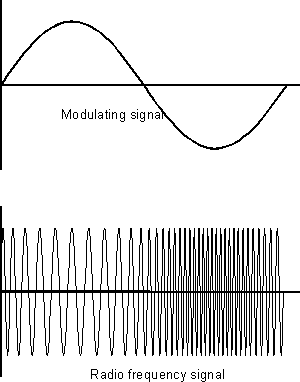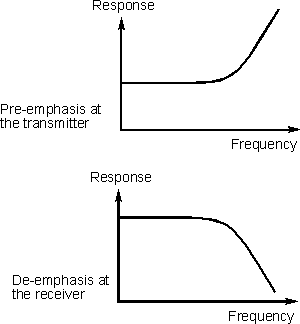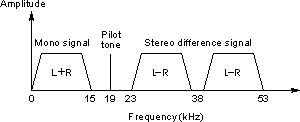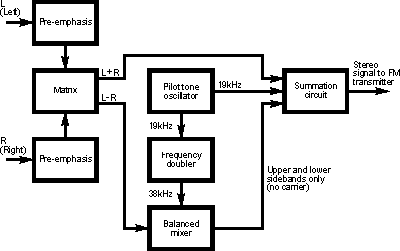Broadcast VHF FM
When broadcasting first started in the 1920s amplitude modulation was used
because it was the obvious and the easiest way to transmit sound. However as
radio technology developed its shortcomings became more obvious and the quest
for higher quality transmissions lead to the introduction of wideband frequency
modulation. Although the first commercial stations were set up in the USA around
1939, it was not until the 1950s that FM started to become really accepted. It
was in 1954 that the BBC announced their intention to start FM broadcasting. Now
VHF FM is the accepted medium for high quality transmissions, and stations that
use AM on the medium and long wave bands have to work hard to retain listeners
who prefer the higher quality of VHF FM.
What is FM?
Amplitude modulation, which is the simplest and most obvious form of modulation
varies the amplitude of the carrier so that it carries the sound information.
Frequency modulation is slightly more subtle and as the name indicates it varies
the frequency of the carrier in line with the variations in the modulating audio
signal. This as the modulating waveform increases in voltage, so the carrier
will swing in one direction and as it decreases it will move in the other
direction.

Figure 1 Frequency modulation
One of the important factors of FM is the degree by which the carrier
changes. This deviation is usually expressed in kilohertz variation either side
of the centre (no modulation) frequency. Typically a signal may have a deviation
of +/- 3kHz if it varies up and down by 3 kHz. There are two main categories on
FM. The first is called narrow band FM, and this is where the deviation is
relatively small, possibly 5 kHz. This type of transmission is used mainly by
VHF / UHF point to point mobile communications. To appreciate the full benefits
of FM, wideband FM is used having a greater level of deviation. The standard for
broadcasting is +/- 75 kHz. To fully accommodate these transmissions a bandwidth
of 200 kHz is used.
The advantage of FM is that as the modulation is carried solely as frequency
variations, much noise, which appears mainly as amplitude variations can be
discarded in the receiver. Accordingly it is possible to achieve much better
noise performance using FM. The upper audio frequency limit is generally taken
as 15 kHz for these transmissions. This is quite adequate for most high quality
transmissions.
Pre-emphasis and de-emphasis
One of the problems with the high quality VHF FM transmissions is that the
increased audio bandwidth means that background noise can often be perceived.
Even then it is considerably better than that obtained using and AM system. It
is particularly noticeable towards the treble end of the audio spectrum, where
it can be heard as a background hiss. To overcome this it is possible to
increase the level of the treble frequencies at the transmitter. At the receiver
they are correspondingly attenuated to restore the balance. This also has the
effect of reducing the treble background hiss which is generated in the
receiver. The process of increasing the treble signals is called pre-emphasis,
and reducing the in the receiver is called de-emphasis. The rate of pre-emphasis
and de-emphasis is expressed as a time constant. It is the time constant of the
capacitor-resistor network used to give the required level of change. In the UK,
Europe and Australia the time constant is 50 uS whereas in North America it is
75 uS.

Figure 2 Pre-emphasis and de-emphasis of a signal
Stereo
In recent years stereo transmission has become an accepted part of VHF FM
transmissions. The system that is used maintains compatibility with mono only
receivers without any noticeable degradation in performance. The system that is
used is quite straightforward.
A stereo signal consists of two channels that can be labelled L and R, (Left
and Right), providing one channel for each of the two speakers that are needed.
An ordinary mono signal consists of the summation of the two channels, i.e. L +
R, and this can be transmitted in the normal way. If a signal containing the
difference between the left and right channels, i.e. L - R is transmitted then
it is possible to reconstitute the left only and right only signals. Adding the
sum and difference signals, i.e. (L + R) + (L - R) gives 2L, i.e. the left
signal, and subtracting the two signal, i.e. (L + R) - (L - R) gives 2R, i.e.
the right signal. This can be achieved relatively simply by adding and
subtracting the two signals electronically. It only remains to find a method of
transmitting the stereo difference signal in a way that does not affect any mono
receivers.
This is achieved by transmitting the difference signal above the audio range.
It is amplitude modulated onto a 38 kHz subcarrier. Both the upper and lower
sidebands are retained, but the 38 kHz subcarrier itself is suppressed to give a
double sideband signal above the normal audio bandwidth as shown below. This
whole of the baseband is used to frequency modulate the final radio frequency
carrier. It is the baseband signal that is regenerated after the signal is
demodulated in the receiver.

Figure 3 The modulating (baseband) signal for a stereo VHF FM
transmission
To regenerate the 38 kHz subcarrier, a 19 kHz pilot tone is transmitted. The
frequency of this is doubled in the receiver to give the required 38 kHz signal
to demodulate the double sideband stereo difference signal.
The presence of the pilot tone is also used to detect whether a stereo signal
is being transmitted. If it is not present the stereo reconstituting circuitry
is turned off. However when it is present the stereo signal can be
reconstituted.
To generate the stereo signal, a system similar to that shown in Fig. 8.5 is
used. The left and right signals enter the encoder where they are passed through
a circuit to add the required pre-emphasis. After this they are passed into a
matrix circuit. This adds and subtracts the two signals to provide the L + R and
L - R signals. The L + R signal is passed straight into the final summation
circuit to be transmitted as the ordinary mono audio. The difference L - R
signal is passed into a balanced modulator to give the double sideband
suppressed carrier signal centred on 38 kHz. This is passed into the final
summation circuit as the stereo difference signal. The other signal entering the
balanced modulator is a 38 kHz signal which has been obtained by doubling the
frequency of the 19 kHz pilot tone. The pilot tone itself is also passed into
the final summation circuit. The final modulating signal consisting of the L + R
mono signal, 19 kHz pilot tone, and the L - R difference signal based around 38
kHz is then used to frequency modulate the radio frequency carrier before being
transmitted.

Figure 4 A simplified diagram of a VHF FM stereo encoder
Reception of a stereo signal is very much the reverse of the transmission. A
mono radio receiving a stereo transmission will only respond to the L + R
signal. The other components being above 15 kHz are above the audio range, and
in any case they will be suppressed by the de-emphasis circuitry.
For stereo receivers the baseband signal consisting of the stereo sum signal
(L+R) and the difference signal (L-R) centred around 38 kHz and the pilot 19kHz
tone are obtained directly from the FM demodulator. The decoder then extracts
the Left only and Right only signals.
The block diagram of one type of decoder is shown below. Although this is not
the only method which can be used it shows the basic processes that are
required. The signal is first separated into its three constituents. The L + R
mono signal between 0 and 15 kHz, the pilot tone at 19 kHz, and the stereo
difference signal situated between 23 and 53 kHz. First the pilot tone at 19 kHz
is doubled in frequency to 38 kHz. It is then fed into a mixer with the stereo
difference signal to give the L - R signal at audio frequencies. Once the L + R
and L - R signals are available they enter a matrix where they are added and
subtracted to regenerate the L and R signals. At this point both signals are
amplified separately in the normal way in a stereo amplifier before being
converted into sound by loudspeakers or headphones.

Figure 5 Block diagram of a stereo decoder
Today most stereo radios use an integrated circuit to perform the stereo
decoding. Often the pilot tone is extracted and doubled using a phase locked
loop. This provides a very easy and efficient method of performing this function
without the need for sharp filters.
|

